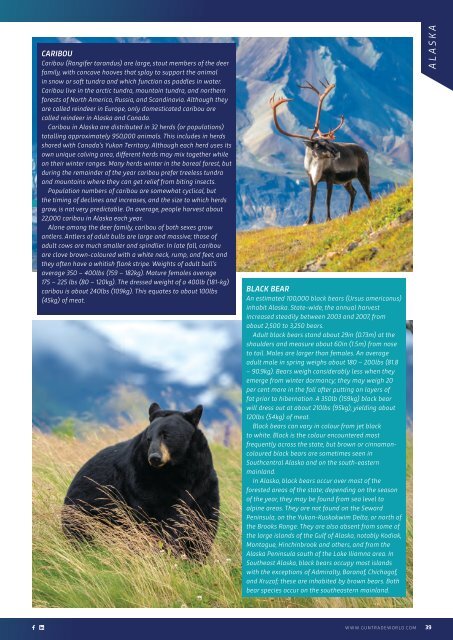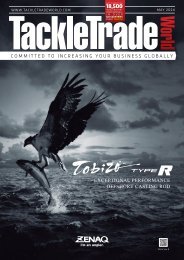You also want an ePaper? Increase the reach of your titles
YUMPU automatically turns print PDFs into web optimized ePapers that Google loves.
CARIBOU<br />
Caribou (Rangifer tarandus) are large, stout members of the deer<br />
family, with concave hooves that splay to support the animal<br />
in snow or soft tundra and which function as paddles in water.<br />
Caribou live in the arctic tundra, mountain tundra, and northern<br />
forests of North America, Russia, and Scandinavia. Although they<br />
are called reindeer in Europe, only domesticated caribou are<br />
called reindeer in Alaska and Canada.<br />
Caribou in Alaska are distributed in 32 herds (or populations)<br />
totalling approximately 950,000 animals. This includes in herds<br />
shared with Canada’s Yukon Territory. Although each herd uses its<br />
own unique calving area, different herds may mix together while<br />
on their winter ranges. Many herds winter in the boreal forest, but<br />
during the remainder of the year caribou prefer treeless tundra<br />
and mountains where they can get relief from biting insects.<br />
Population numbers of caribou are somewhat cyclical, but<br />
the timing of declines and increases, and the size to which herds<br />
grow, is not very predictable. On average, people harvest about<br />
22,000 caribou in Alaska each year.<br />
Alone among the deer family, caribou of both sexes grow<br />
antlers. Antlers of adult bulls are large and massive; those of<br />
adult cows are much smaller and spindlier. In late fall, caribou<br />
are clove brown-coloured with a white neck, rump, and feet, and<br />
they often have a whitish flank stripe. Weights of adult bull’s<br />
average 350 – 400lbs (159 – 182kg). Mature females average<br />
175 – 225 lbs (80 – 120kg). The dressed weight of a 400lb (181-kg)<br />
caribou is about 240lbs (109kg). This equates to about 100lbs<br />
(45kg) of meat.<br />
BLACK BEAR<br />
An estimated 100,000 black bears (Ursus americanus)<br />
inhabit Alaska. State-wide, the annual harvest<br />
increased steadily between 2003 and 2007, from<br />
about 2,500 to 3,250 bears.<br />
Adult black bears stand about 29in (0.73m) at the<br />
shoulders and measure about 60in (1.5m) from nose<br />
to tail. Males are larger than females. An average<br />
adult male in spring weighs about 180 – 200lbs (81.8<br />
– 90.9kg). Bears weigh considerably less when they<br />
emerge from winter dormancy; they may weigh 20<br />
per cent more in the fall after putting on layers of<br />
fat prior to hibernation. A 350lb (159kg) black bear<br />
will dress out at about 210lbs (95kg), yielding about<br />
120lbs (54kg) of meat.<br />
Black bears can vary in colour from jet black<br />
to white. Black is the colour encountered most<br />
frequently across the state, but brown or cinnamoncoloured<br />
black bears are sometimes seen in<br />
Southcentral Alaska and on the south-eastern<br />
mainland.<br />
In Alaska, black bears occur over most of the<br />
forested areas of the state; depending on the season<br />
of the year, they may be found from sea level to<br />
alpine areas. They are not found on the Seward<br />
Peninsula, on the Yukon-Kuskokwim Delta, or north of<br />
the Brooks Range. They are also absent from some of<br />
the large islands of the Gulf of Alaska, notably Kodiak,<br />
Montague, Hinchinbrook and others, and from the<br />
Alaska Peninsula south of the Lake Iliamna area. In<br />
Southeast Alaska, black bears occupy most islands<br />
with the exceptions of Admiralty, Baranof, Chichagof,<br />
and Kruzof; these are inhabited by brown bears. Both<br />
bear species occur on the southeastern mainland.<br />
alaska brazil<br />
www.guntradeworld.com 39


















